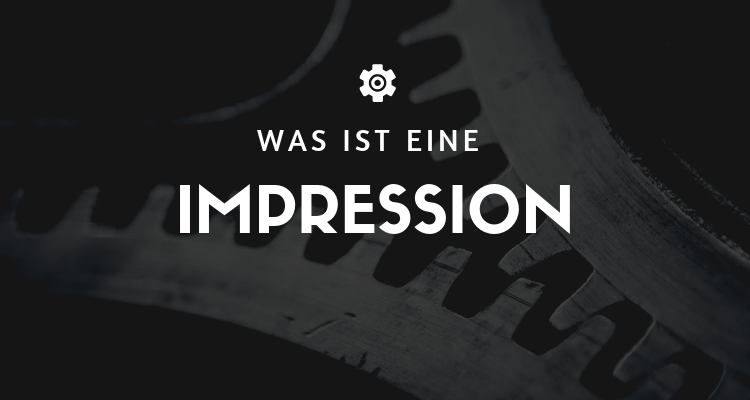
What is an impression?
An impression occurs whenever an advertisement or other form of digital media is played on a user's screen. Impressions are not action-based and are simply defined by a user (potentially) seeing the ad. This makes what CPM campaigns ideal for companies looking to expand their brand awareness.
Impressions in digital marketing
Through impression tracking, it has become possible in digital marketing to track how often an advertisement has been seen. This is a great advantage that offline marketing cannot offer. For example, a billboard owner has no concrete way of estimating how often his ads were seen/read by people. Impression-based online campaigns, on the other hand, make it possible to measure these values concretely and are usually sold in the form of cost-per-thousand (CPM).
This type of tracking is a common metric for measuring the performance of different types of Online Marketing-Campaigns, including:
- Pay-per-click impression, measured by actual clicks
- Number of times a meme appears on social media
- On-site views of internal calls-to-action (CTA)
- Access to imagery via third-party websites, such as Pinterest or Google Image Search.
In general, there are two types of impressions: "served" and "viewable".
Served impressions
By default, online impressions are tracked via "served content": When a marketing-related file is accessed and transferred, this activity counts as an impression. This is extremely easy to track, as this process is based on pure server data.
Counting impressions based on served content, still has the problem of "billboarding". It's hard to tell how much influence the content had without deeper data analysis. Also, in some cases, files can be accessed without being visible to the consumer.
Viewable Impressions
The viewable impressions method uses data collected from a user's device. The reason for this is that the measurements can be refined by excluding the impressions that were most likely not viewed.
This type of tracking makes it possible to track user behavior (including how users bypass ad viewing):
- Ad Block Software
- The screen resolution is too small for the ad (advertisement) to be displayed on the screen
- User scrolls down before the ad can load
- Faulty plugins prevent the correct display of content
- Mobile incompatibilities due to desktop-only websites
- Minimized browser windows
- Websites loaded in background tabs but never opened in the end
- Interference from non-users, such as advertisements that disguise malware
Viewable impressions have two advantages:
- A company more accurate information about the number of actual impressions
- Secondly, the data collected is very valuable and allows improvements to one's website before
Properly used, this offers the possibility of your Ranking in Google by quite a bit, if you read correctly.
Google Search Console to examine impressions
To compare your website impressions with the Google Search Console you must first make sure that your website is verified on Google Search Console. If this is not the case, you need to verify your website first.
- Log in to your Google Search Console account.
- Select the website you want to investigate.
- Click on the "Performance" tab
- Here you can see the impressions, clicks, CTR and see the average position for your website.
- You can also view impressions and clicks for specific pages, queries, devices, and locations by selecting the appropriate filters.
- You can also view your dates in different time periods by clicking on the date menu.
- If you want more information about the queries that led to impressions for your pages, go to the "Search queries" tab
- Here you can see which search queries led to your website and which pages were displayed.
It is important to note that the data in Google Search Console is usually provided with a delay of a few days. So it is possible that the data you see is not the most up-to-date.
There are also other tools like Google Analytics, which can provide you with similar information, but Google Search Console gives you deeper insight into your website's search results.
Google Analytics to investigate impressions
To examine your website impressions with Google Analytics, you must first make sure that Google Analytics is set up on your website. If this is not the case, you must first set up Google Analytics on your website.
- Log in to your Google Analytics account.
- Select the website you want to investigate.
- Click on the tab "Users" and then on "Overview
- Here you can see the number of sessions, the number of users and the bounce rate for your website.
- You can also see the number of page views and average session duration for your website.
- You can also view your dates in different time periods by clicking on the date menu.
- If you want more information about the queries that led to impressions for your pages, go to the "Aquisition" tab and then to "Search engines".
- Here you can see which search queries led to your website and which pages were displayed.
It is important to note that the data in Google Analytics is usually provided with a delay of a few hours. So it is possible that the data you see is not the most up-to-date.
Impressions advantages
A significant advantage of impressions is that they allow the Range of a campaign and understand which websites and social networks are most important to a campaign. Impressions can also help measure the effectiveness of a campaign and compare how the campaign is performing against other campaigns.
In addition, impressions can help optimize a campaign by helping to identify the ads that work best. This way, companies can improve their campaigns and maximize results.
Impressions disadvantages
Impressions are not always a reliable indicator of the effectiveness of a campaign. Since they only measure the number of times an ad is shown, they do not convey any information about whether a user clicks on the ad or decides to make a purchase.
It's also difficult to measure the quality of impressions. For example, if an ad is displayed on a low-quality website, the ad may be uninteresting to the user and reduce the effectiveness of the campaign.
Use cases
Impressions are particularly helpful in measuring and understanding the effectiveness of online ads. By measuring the number of times an ad is displayed, companies can Range of a campaign and understand which websites and social networks are most relevant to the campaign.
In addition, impressions can help optimize a campaign by helping to identify the ads that work best. Impressions also allow companies to measure the effectiveness of a campaign against other campaigns to see which strategies are most successful.
Conclusion
Impressions are a valuable way to measure the effectiveness of online ads and understand how a campaign is performing compared to other campaigns. They can help to Range of a campaign and understand which websites and social networks are most important for a campaign. In addition, impressions can help identify the ads that work best and optimize the results of a campaign. However, impressions cannot fully measure the actual effectiveness of a campaign because they do not provide information about whether a user clicks on the ad or decides to make a purchase.
« Back to Glossary Index




 By
By 